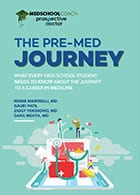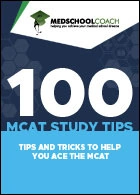
Table of Contents
MD-PhD programs are dual-degree programs for pre-medical students who want to both practice medicine and conduct extensive research.
In an MD-PhD program, the medical education of the MD program is combined with the in-depth research training of a PhD program. Students learn to practice medicine, diagnosing and treating patients all while gaining research experience to investigate medical conditions and diseases.
These programs are more intense than standard medical school. Students take additional coursework, typically in the biomedical sciences, graduate training, rotations in different laboratories, and intensive research.
The extra education gives students the tools to advance in the medical field after graduation. If you are interested in investigating diseases as you treat patients and developing innovative ways to provide care, an MD-PhD path may be for you!
What are MD-PhD programs?
MD-PhD programs are unique dual-degree programs designed for students who have an interest in both patient care and research. In these programs, students complete both a medical degree (MD) and a doctorate (PhD). This prepares graduates to function as physician-scientists, seamlessly bridging the gap between the laboratory and the clinical setting.
What is the difference between an MD and an MD-PhD? The difference between MD and MD-PhD graduates is that while both degrees are conferred to medical doctors, MD programs focus on clinical practice. MD-PhD programs, on the other hand, combine medical education with extensive biomedical research training.
Is MD-PhD easier than MD? MD-PhD programs are not easier than MD programs. They require a longer time commitment, but in the end, provide graduates with a broader skill set to pursue careers that integrate medicine and scientific research.
How rare is an MD-PhD? Only about 3% of students that enroll in medical school are in MD-PhD programs. There are 122 MD-PhD programs in the U.S. and 13 in Canada listed on the AAMC MD-PhD Degree Programs by State directory.
Graduate programs aren’t confined to a specific area of study. Each school with this type of program has its own options for its PhD degree. PhD students commonly choose to specialize in topics such as:
- Cell biology
- Biochemistry
- Pharmacology
- Physiology
- Genetics
- Immunology
- Neuroscience
- Biomedical engineering
Upon completion of an MD-PhD program, graduates are awarded the dual degree for their proficiency in both clinical practice and research.
MD-PhD Program Duration
A significant commitment of time is necessary to complete an MD-PhD program, but the career path is rewarding and well-compensated.
How many years are MD-PhD programs? Students can expect to spend 7-8 years total between graduate school and med school, but there is no strict timeline for completing an MD-PhD. Some students complete their programs in as little as six years, and others take as long as 10.
Students usually start with the first year to two years of medical school, followed by 3-5 years of research, then finish with another two years of medical training and clinicals. Current students entering into MD-PhD programs are older, on average, than when these programs first began, and many take longer to complete their studies.
How much does an MD-PhD program cost?
Most MD-PhD programs offer enrolled students tuition-free training and a stipend to cover living expenses.
The cost of an MD-PhD program varies widely depending on the institution, but the stipend and tuition-free training makes many of these programs significantly less burdensome financially compared to standalone MD or PhD programs.
Financial support is available through the Medical Scientist Training Program (MSTP) funded by the National Institutes of Health (NIH). Scholarships are offered that cover tuition and provide a stipend for living expenses, making these intensive dual degree programs more attainable.
Not all MD-PhD programs are funded by the MSTP, but some schools offer similar financial support to their MD-PhD students. For any school you plan to apply to, double-check their program website or call an admissions counselor to see if there are options for financial aid.
MD-PhD Residencies
MD-PhD residencies provide a unique opportunity to bridge the gap between patient care and research. Graduates often enter residency programs to acquire hands-on training in a particular medical specialty. Some even opt for a fellowship in a subspecialty after that. This training phase can range from 3 -7 years, depending on the specialty.
Although they can enter any medical specialty, they frequently gravitate towards specialties with a strong research component. Here are a few common residencies that MD-PhDs typically enter:
- Internal Medicine: This field covers a broad range of diseases in adults and often involves solving complex medical problems. It’s a popular choice for MD-PhD graduates because of the diversity of patients and conditions, which provides many opportunities for research.
- Neurology: The complexity and the largely untapped understanding of the nervous system provide abundant research opportunities. Advances in neuroimaging, AI, and genetics also offer tools for physician-scientists to explore the nervous system in unprecedented ways.
- Psychiatry: Studying the pathophysiology of mental disorders, exploring new therapeutic interventions, and examining the genetic basis of psychiatric conditions are just a sample of the ways an MD-PhD can continue research in this specialty.
- Pathology: Pathologists often work behind the scenes in medicine, studying the causes and effects of diseases. This field is deeply rooted in medical research, which makes it a good fit for many MD-PhD graduates.
- Pediatrics: Pediatric physician-scientists research a wide array of topics, including childhood diseases, growth and development, pediatric therapies, and many other areas related to child health.
The choice of residency program should align with each graduate’s clinical interests, research interests, and career goals. There is great flexibility in the MD-PhD pathway, and physician-scientists span all specialties in medicine.
MD-PhD Career Path & Salary
Careers for MD-PhD’s often sit at the intersection of healthcare, academic medicine, and industry. Roles vary from practicing physicians, medical researchers, educators, and policy advisors to leaders in biotech and pharmaceutical companies.
After completing their residency, MD-PhDs typically divide their professional time between research and clinical practice. They often work in academic medical centers or research institutions where they can see patients and conduct research. Their research may be basic, translational, or clinical, depending on their interests and training.
MD-PhDs may also grow to take on teaching roles, educating the next generation of physicians and scientists. This path can bring them to leadership roles such as department chair, dean of a medical college, or even hospital CEO with their unique understanding of both medicine and research.
The salary for MD-PhDs does vary depending on the chosen career path. Earning potential is generally high due to the advanced and specialized nature of their training.
On average, physician-scientists in the US earn a median salary that is well above the national average for all occupations. According to Doximity’s 2023 Physician’s Compensation Report, the average salary for physicians in the Pharmaceutical/Industry employment setting is highest at $392,534.
Those working in academia or research may have different salary scales. These salaries are frequently dependent on research grants, but still typically fall within a comfortable range.
An MD-PhD opens up a wide range of career options, particularly in the intersecting areas of healthcare and research. Below are careers someone with an MD-PhD might pursue:
- Academic Physician: They divide their time between seeing patients, conducting research, and teaching students and residents. These professionals usually work at medical schools or teaching hospitals.
- Biomedical Researcher: MD-PhDs often find employment as researchers in the field of biomedical sciences. They can work in research institutions, pharmaceutical companies, or government organizations such as the NIH.
- Clinical Investigator: These are physicians who conduct research involving human subjects (clinical trials). They develop and implement studies to understand the effects of new drugs or therapeutic strategies.
- Pharmaceutical/Biotech Industry Professional: Many MD-PhDs work in the pharmaceutical or biotechnology industry. They may be involved in drug development, clinical trials, regulatory affairs, or medical affairs.
- Medical Director: In this role, an individual would oversee the medical aspect of a healthcare facility, biotech company, or department in a hospital. This position often requires both a medical and research background.
- Science Policy Analyst/Advisor: They can work in government or nonprofit organizations, helping to shape policies that affect scientific research and healthcare.
- Public Health Official: Some MD-PhDs choose to work in the public sector, addressing health issues at the population level. They may work for entities like the Centers for Disease Control and Prevention (CDC) or World Health Organization (WHO).
- Medical Science Liaison: This role often involves serving as a bridge between pharmaceutical companies and healthcare professionals, explaining new therapies and scientific findings to physicians, researchers, and other stakeholders.
- Medical Educator: MD-PhDs are uniquely qualified to educate future doctors and researchers, teaching in areas such as pharmacology, pathology, genetics, or any other medical specialty. They may design and implement courses, advise students, and contribute to the educational mission of their institution.
These are just a few of the potential career paths. A career choice often depends on an individual’s specific interests, such as which medical specialties they are drawn to, whether they prefer working with patients or in a laboratory, and how they want to contribute to advancing medical science.
Medical Science Training Programs
Some MD-PhD programs in the United States are funded by the National Institutes of Health (NIH) through the Medical Scientist Training Program (MSTP). This means that students receive full tuition remission, health insurance, and a living stipend throughout their training.
Because of this financial support, admission to an MSTP is very competitive. Many schools have financial support available to MD-PhD students even if they are not part of the Medical Scientist Training Program to allow them to focus on their studies and research.
Be better prepared for your MCAT with a free practice exam.
4 Benefits of Becoming an MD-PhD
Earning dual degrees in medicine and research is an ambitious endeavor, but the impacts you can make on patient care and scientific research are significant and valuable to public health. An MD-PhD degree comes with some great benefits.
1. Interdisciplinary Perspective
The duality of the MD-PhD training allows graduates the ability to translate clinical observations into research questions, then taking research findings to enhance patient care. You will essentially be a bridge to the gap between the laboratory and the clinic.
2. Career Flexibility
Graduates can become practicing physicians, medical researchers, educators, and/or policy advisors. They may also take on leadership roles within academic institutions, hospitals, biotech companies, or pharmaceutical firms.
The wide range of possible careers allows the flexibility to pursue a path that aligns with your passion.
3. Influential Impact
The rigorous training in MD-PhD programs allows graduates to drive innovation in healthcare and medical science. This advanced education will have you asking critical questions and finding answers that can change the course of medical treatment and patient care.
The potential to make significant contributions to the field of medicine is a rewarding and prestigious aspect of this career path.
4. Community and Mentorship
During their training, MD-PhD students join a tight-knit community of fellow dual-degree students, mentors, and faculty. This network can provide valuable support, guidance, and camaraderie during the demanding years of study.
Post-graduation, this network continues to serve as a resource for collaboration, mentorship, and career advancement.
Are MD-PhD programs more competitive than MD programs?
In general, yes, MD-PhD programs are more competitive than MD programs.
The statistics here can be a little confusing, though. 10% of applicants are accepted to an MD-PhD program, which is higher than the 3% that get accepted into MD programs. Acceptance rates are nearly the same as traditional medical programs, too.
But the quality of application for MD-PhD programs is inherently higher than traditional pre-meds. Your GPA and MCAT need to be higher, with well-developed extracurricular experiences and glowing letters of recommendation to have a chance at an MD-PhD program.
Learn more about how we can help you boost your MCAT score.
Preparing to Apply to MD-PhD Programs
Applying for an MD-PhD program is done through AMCAS, just like MD programs. Preparation is key in the application process.
Being proactive, getting relevant experiences, understanding the requirements, and applying to multiple programs will significantly enhance your chances of success in securing a spot in an MD-PhD program. Applicants must be prepared to showcase themselves as doctor material and make a case for their desire to take part in research.
Here are a few tips for increasing your chances at acceptance.
Make sure you have the right extracurriculars under your belt.
Gaining relevant experiences beyond the classroom is crucial to showcase your commitment to a career in medical research. Admissions committees are looking for candidates with experience in research projects.
It is absolutely necessary to have taken part in research to have a chance at getting into an MD-PhD program.
Check application requirements well in advance.
You’ll be required to meet all the AMCAS application requirements of MD programs. This includes the prerequisite coursework, your MCAT score and GPA, letters of evaluation, and personal statement.
There are also two additional essays that are required on MD-PhD applications, which we’ll cover later.
We advise checking with each specific medical school on the requirements for their applications. Non-medical graduate programs may ask for your GRE scores. You want to make sure you’ve taken this test well in advance of the AMCAS open date.
Our advisors can help you craft a personal statement for your MD-PhD that will stand out.
Apply to several programs.
Because of the limited number of programs and the competitive nature of MD-PhD programs, you should apply to multiple programs. Students who have gotten into these programs report applying to as many as 30 programs for the best chance to be accepted.
Along with MD-PhD programs, we also recommend applying to some MD programs as well. On your AMCAS application, you can easily designate as an MD candidate or MD-PhD candidate.
Even if you don’t make it into the MD-PhD program of a medical school, you will still have the opportunity to be considered for their MD program.
MD-PhD Application Timeline
Get your medical school application in early — the same goes for MD-PhD applications. In fact, it’s even more important to have your primary application in as soon as possible to give yourself plenty of time to write your secondary essays.
The MD-PhD application process follows the AMCAS application timeline:
- May: AMCAS application opens. You’ll receive your secondary application shortly after you submit your primary.
- July-August: Submit your supplemental application within two weeks.
- October-March: Prepare for and attend all scheduled interviews.
- December-March: Application committees make final decisions. For schools with rolling admissions, this may happen shortly after an interview. Other institutions wait until after all interviews are complete to make decisions.
- March-April: Applicant decisions are made.
- June-August: Your MD-PhD begins.
Additional Essays in the MD-PhD Application
The MD-PhD application process includes two additional essays that showcase your commitment to a career as a physician-scientist.
MD-PhD Essay
The MD-PhD Essay is your opportunity to express why you have chosen the dual-degree path and how it aligns with your career goals. Discuss your motivation for pursuing the ambitious MD-PhD degree. You should explain why both clinical practice and research are integral to your career vision and share personal experiences that ignite your interest in this path.
Describe your career goals and how integrating clinical practice and scientific research will allow you to achieve those goals. If you’re interested in a particular field, discuss how the blend of clinical and research training in the MD-PhD program will enhance your contributions to this field.
Significant Research Experience Essay
This essay is your chance to elaborate on your research experiences and demonstrate your scientific curiosity, perseverance, and ability to work independently. You’ll explain the objectives of the research project you have been involved in, your role in achieving these objectives, and the significance of the research.
You can also write about instances where you faced challenges and had to use your problem-solving skills, perseverance, and critical thinking to overcome them. Highlight your ability to learn from others, like your mentors, how you can collaborate, and contribute to a team-oriented goal.
If your work led to any significant findings, presentations, or publications, be sure to include this. Use this opportunity to communicate your passion for research and how these experiences have prepared you for a career that combines patient care and scientific investigation.
MD-PhD: The career path that moves medicine forward.
MD-PhD candidates have a commitment to both medical practice and research on this path. The journey is long and at times challenging, but for those driven by a passion for both clinical medicine and biomedical research, the reward lies in the unique ability to contribute to the advancement of healthcare as a physician-scientist.
Speak with a member of our enrollment team who can help you prepare your MD-PhD application.

Kachiu Lee, MD
Dr. Lee specializes in BS/MD admissions. She was accepted into seven combined bachelor-medical degree programs. She graduated Summa Cum Laude from Northwestern University and proceeded to Northwestern University’s Feinberg School of Medicine in Chicago, IL. After completing a dermatology residency at Brown University, Dr. Lee pursued a fellowship in Photomedicine, Lasers, and Cosmetics at Massachusetts General Hospital and was a Clinical Fellow at Harvard Medical School. Academically, she has over 100 peer-reviewed publications and lectures internationally.











